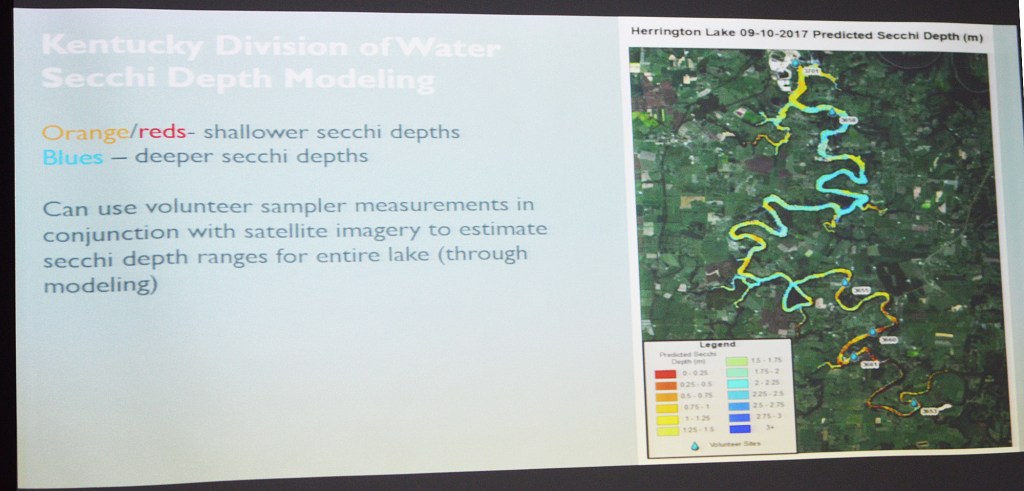Organizers say resident volunteers fulfill important role in water testing due to DOW staffing
Published 8:08 am Friday, February 16, 2018

- Photo graphics by the KY DOW The Kentucky Division of Water secchi depth modeling map shows how volunteer water sample measurements in conjunction with satellite imagery is used to estimate secchi depth ranges for Herring Lake. A secchi disc is a black and white opaque disk attached to a rope that researchers slowly lower into a body of water to measure the depth at which the disk ceases to be visible from the surface. McAlister said, its a very common and simple tool that volunteer lake sampling programs use throughout the country to find out more about water clarity and the photic zone.
Citizen scientists get feedback from research completed
Local residents who volunteered for a state program monitoring Herrington Lake water clarity last year got to see what their citizen scientist research accomplished this week. They also learned why the data they collected is so important.
On Tuesday afternoon, Malissa McAlister with the Kentucky Water Resources Research Institute (part of the Kentucky Division of Water) and Colin Arnold, a fish biologist at the DOW, met with the group of volunteers who participated in the pilot program and presented their findings.
They also discussed how the newly developed app and process of data recording for the program can be made more efficient so that other volunteer programs across the state can use them for their test sites.
McAlister said using the water clarity data collected by volunteers every two weeks over a three-month period and satellite imagery, water researchers were able to devise a map of the lake with improved accuracy of the agency’s model predictions of clarity at any given time without having a DOW researcher on site.
“The DOW is is very low-staffed right now, so having volunteer samplers out there — just even looking and reporting anything that seems off — is very helpful to them,” McAlister said.
The DOW closely monitors each Kentucky lake about every five years. And with a small staff monitoring all the lakes, “If we see something on these images, it will allow us to get out and actually check on it. We can’t just go to every lake all the time,” Arnold said.

Satellite images of Herrington Lake show how researchers can alter color waves to look for changes in the water’s clarity and determine what may be causing the changes.
McAlister said with the feedback from volunteers, the DOW wants to make sure the app and process work before expanding its use. “Let’s make sure we can get it to work before we expand it to hundreds of people across the state” who want to use the volunteer sampling program at other lakes and streams, she said.
McAlister said clarity is important to track because it shows scientists the photic zone, “which is the depth that photosynthesis can occur and helps to better understand the productivity of the lake.”
“Water clarity also shows the levels of nutrients in the lake, and that gives us a better comprehensive understanding of how healthy and active the lake is,” McAlister said.
During the pilot program, volunteers lowered a black and white disc into the water at specific locations and measured how deep it was when the disc could no longer been seen. They also noted weather and lake conditions on that particular day.
Things that impact clarity include sediments running off land after a rain, churned water from boats and toxic algae growths.
“Typically where there’s more and more activity on the lake and water running off the land and development,” water can get choked with algae growth and not enough oxygen is dissolved in the water to support fish and aquatic life, McAlister said.
Poor water clarity and algae growth can also be attributed to the depth of the water, fertilizer run-off and sewage. And as the algae increases, water clarity decreases, McAlister said.
During July through the end of October, 10 volunteers took a total of 42 site readings at 10 locations, ranging from the headwaters near Bryant’s Camp up closer to the dam.
Water quality professionals classify a lake’s oxygen and nutrient balance in four categories: oligotrophic, which contains a lot of oxygen but not much nutrients; mesotrophic, which contains a balance of oxygen and nutrients; eutrophic, which has so many plants and nutrients that it decreases oxygen levels in the water, which can kill aquatic life; and hypereutrophic, which is when the body of water is so out-of-balance ecologically that fish and other wildlife die.
Water clarity at Herrington ranged from and average of about half a meter in a shallow area of the lake to 1.79 meters in a deeper area.
From data he has seen and from talking with other lake experts, Arnold said he thinks Herrington Lake is currently in the eutrophic range — down from the mesotrophic range.
Talking to the group, McAlister said, “Your observations are very helpful with the Division of Water’s modeling efforts to detect something that is becoming more and more of an issue in this country and throughout the world. Harmful algae blooms can be toxic and can make pets and humans sick.”
“It’s really cool and very valuable data for the monitoring of the algae blooms, and we kind of automated it a little bit” by correlating the clarity data with satellite images of the lake, McAlister said.
Arnold said his vision was to one day have more volunteers on more lakes to monitor long-term trends.
McAlister said she was happy with the cooperation of the volunteer group, and glad they are willing to keep going when the program begins monitoring again in the spring. She hopes to recruit more volunteers interested in the lake’s condition to help monitor Herrington, and said a workshop will be held to teach volunteers the scientific methods used in the research project.
And if the DOW can find grants to apply for in order to help with funding, Arnold said he would like to expand the volunteer monitoring program so that a few volunteers would have special equipment and be trained to check on water quality.
Volunteer and lake resident Julie Pease said she was glad to learn that their research was helpful.
“I now know what and why we were doing what we were doing and that it does have an impact on research.”
To see the map of Herrington Lake with sampling data go to kgs.uky.edu/wwky/lake






